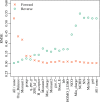Chemical Descriptors for a Large-Scale Study on Drop-Weight Impact Sensitivity of High Explosives
- PMID: 36695777
- PMCID: PMC9930127
- DOI: 10.1021/acs.jcim.2c01154
Chemical Descriptors for a Large-Scale Study on Drop-Weight Impact Sensitivity of High Explosives
Abstract
The drop-weight impact test is an experiment that has been used for nearly 80 years to evaluate handling sensitivity of high explosives. Although the results of this test are known to have large statistical uncertainties, it is one of the most common tests due to its accessibility and modest material requirements. In this paper, we compile a large data set of drop-weight impact sensitivity test results (mainly performed at Los Alamos National Laboratory), along with a compendium of molecular and chemical descriptors for the explosives under test. These data consist of over 500 unique explosives, over 1000 repeat tests, and over 100 descriptors, for a total of about 1500 observations. We use random forest methods to estimate a model of explosive handling sensitivity as a function of chemical and molecular properties of the explosives under test. Our model predicts well across a wide range of explosive types, spanning a broad range of explosive performance and sensitivity. We find that properties related to explosive performance, such as heat of explosion, oxygen balance, and functional group, are highly predictive of explosive handling sensitivity. Yet, models that omit many of these properties still perform well. Our results suggest that there is not one or even several factors that explain explosive handling sensitivity, but that there are many complex, interrelated effects at play.
Conflict of interest statement
The authors declare no competing financial interest.
Figures

 , are highlighted. 2,4,6-TNT has a slightly
wider eigenspectrum than PETN, which is measured by the normalized
second moment,
, are highlighted. 2,4,6-TNT has a slightly
wider eigenspectrum than PETN, which is measured by the normalized
second moment,  . Both eigenspectra exhibit positive skewness,
. Both eigenspectra exhibit positive skewness,  , which is larger for 2,4,6-TNT, and moderately
unimodal distributions, s ≈ 1.
, which is larger for 2,4,6-TNT, and moderately
unimodal distributions, s ≈ 1.



 of the selected model when adding each
descriptor in turn (“forward”) and removing each descriptor
in turn (“backwards”).
of the selected model when adding each
descriptor in turn (“forward”) and removing each descriptor
in turn (“backwards”).

References
-
- DOE Explosive Safety Standard; DOE-STD-1212-2012; U.S. Department of Energy, 2012.
-
- Rae P. J.; Dickson P. M. Some Observations About the Drop-weight Explosive Sensitivity Test. J. Dyn. Behav. Mater. 2021, 7, 414–424. 10.1007/s40870-020-00276-2. - DOI
-
- Davis W. C. High Explosives: The Interaction of Chemistry and Mechanics. Los Alamos Science 1981, 2, 48.
-
- Cheng R.; Zecevic M.; Moore J.; Cawkwell M.; Manner V. W.. Large Deformation GNARLYX Hydrocode Simulations of the Drop Weight Impact Experiment. In Review, 2022.
Publication types
MeSH terms
Substances
LinkOut - more resources
Full Text Sources

